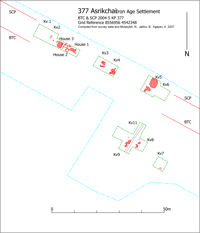Kp 377
References: Museyibli et al. 2007b
Archive files

Asrikchai (377) excavation plan
Kp 377
References: Museyibli et al. 2007b
Archive files

Asrikchai (377) excavation plan
The site lies at the top of a narrow area of level land either side of the slopes to the Asrikchai River to the east and the Tovuzchai River to the west. Part of the site was identified and recorded in 2004 with further areas being recorded in early 2005.
Parts of the site were distinguished by spreads of pottery and occasional evidence of burning.
The first period of excavation in 2004 (KV1-2) found comparatively little evidence beyond spreads of pottery and burnt soil. It appeared that the major elements of the site had been removed by erosion and damage by pipeline machinery. At the end of 2004, observation of pipe trenching showed that there were substantial surviving deposits in between the previously excavated KV2 and KV3. Excavation here revealed three pithouses sunk into the ground. These houses contain substantial quantities of pottery, including complete vessels, all of which were covered by a depth of soot and ash.
The interpretation is that the structures had been destroyed by fire, possibly as part of an annual fumigation or sterilisation of the site.
The material from the site is of the Khojahly-Gedabey Culture and dates to the 9-8th centuries BC.
© Internet Archaeology/Author(s)
University of York legal statements | Terms and Conditions
| File last updated: Fri Jun 17 2011